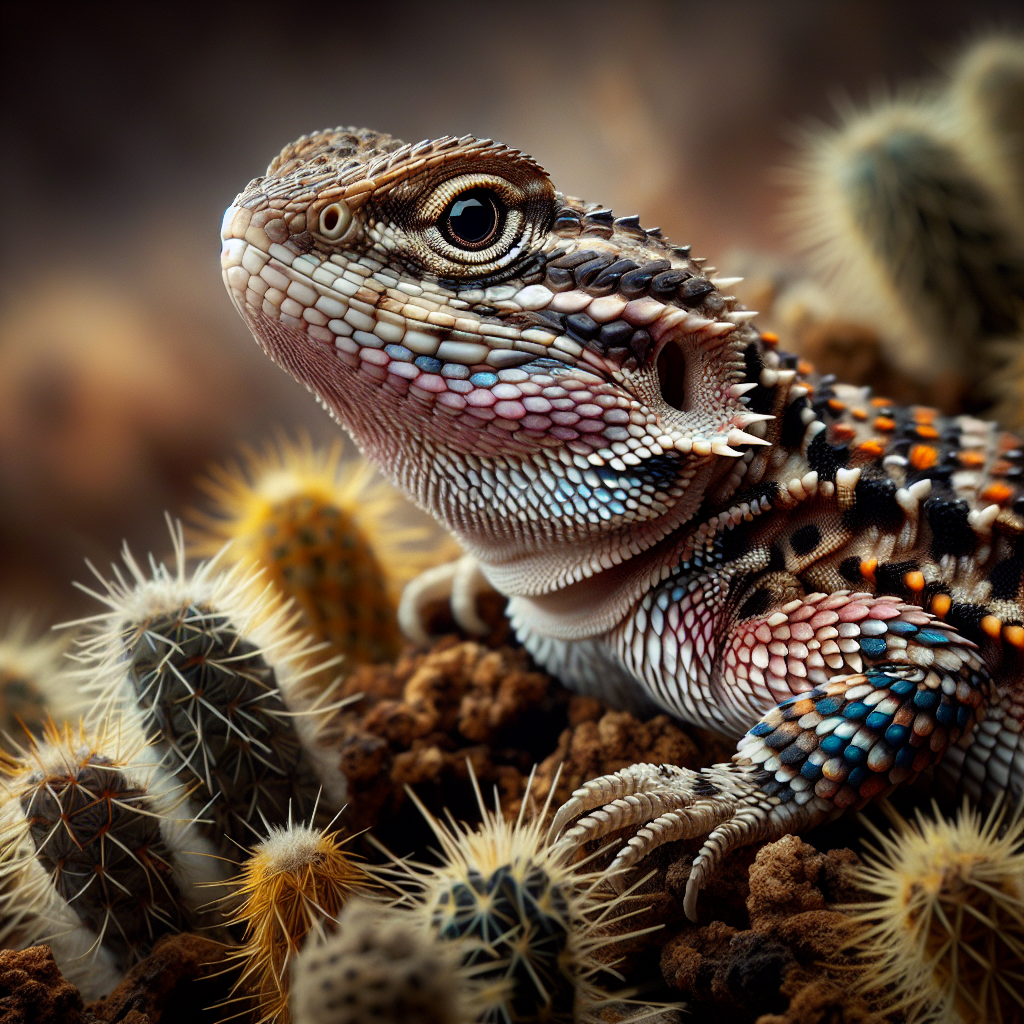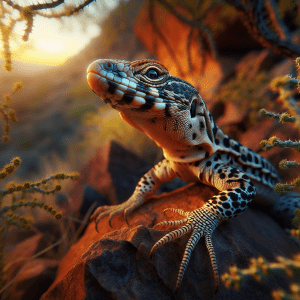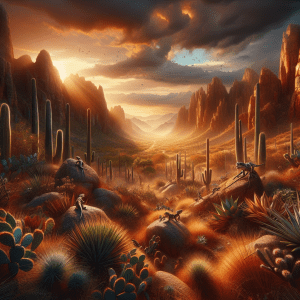Introduction to Lizard Diversity in the Sonoran Desert
Have you ever marveled at the incredible diversity of lizard species thriving in the Sonoran Desert? Picture this: a sunlit landscape, dotted with rocks and cacti, where lizards scurry around, their scales glistening in the desert heat. It’s a mesmerizing sight that never fails to captivate me.
Let’s delve into the fascinating world of lizard diversity in the Sonoran Desert. Did you know that this arid region is home to an array of lizard species, each uniquely adapted to survive in this harsh environment? From the iconic Gila monster to the agile collared lizard, these reptiles play a crucial role in maintaining the delicate balance of the desert ecosystem.
As an expert in lizard biology, I’ve had the privilege of studying these remarkable creatures up close. One thing that never ceases to amaze me is the sheer variety of behaviors and adaptations displayed by Sonoran Desert lizards. From camouflaging to avoid predators to basking in the sun to regulate their body temperature, each species has its own survival strategies honed by millions of years of evolution.
But amid the awe-inspiring beauty of lizard diversity lies a pressing concern: the impact of human activities on their fragile habitats. Conservation efforts are more critical than ever to ensure the survival of these magnificent creatures for future generations to appreciate.
So, as we unravel the mysteries of lizard diversity in the Sonoran Desert, let’s not just admire from afar. Let’s take action to protect these fascinating creatures and the unique ecosystem they call home. Together, we can ensure that the enchanting dance of lizards in the desert continues for years to come.
Importance of Lizards in the Ecosystem
Imagine standing in the vast Sonoran Desert, surrounded by the scorching sun and rugged landscapes. Now picture a small, unassuming lizard darting across the sand, blending effortlessly into its surroundings. These creatures may seem insignificant at first glance, but let me tell you, they play a crucial role in this harsh environment.
Lizards in the Sonoran Desert are true masters of adaptation. With their ability to regulate body temperature and survive on minimal water, they have evolved remarkable strategies to thrive in this arid land. It’s like they have unlocked the secrets of survival in one of the harshest environments on Earth.
Now, let me share a fascinating fact with you. Did you know that some Sonoran Desert lizards can change color to match their surroundings? It’s like they have their own superpower, allowing them to camouflage and escape from predators with ease. Nature truly is full of wonders!
As we delve deeper into the world of Sonoran Desert lizards, we uncover a web of interconnectedness that binds these creatures to their environment. They are not just inhabitants of the desert; they are essential players in maintaining the delicate balance of this ecosystem.
So, the next time you spot a lizard scurrying across the desert sands, take a moment to appreciate the resilience and beauty of these fascinating creatures. They may be small, but their impact on the Sonoran Desert is nothing short of extraordinary.
Unique Adaptations of Sonoran Desert Lizards
Have you ever wondered how Sonoran Desert lizards manage to thrive in such harsh conditions? Let me tell you, these little reptiles are true masters of adaptation! Take the chuckwalla, for instance. This chubby lizard has specialized skin that helps it absorb and retain water in the arid desert environment. It’s like having a built-in hydration system! And then there’s the horned lizard, also known as the “horny toad.” This spiky creature has a unique defense mechanism – it shoots blood from its eyes to scare off predators! Talk about a dramatic exit strategy, right?
Now, imagine yourself in the Sonoran Desert, observing these incredible creatures in their natural habitat. You might spot a collared lizard sprinting across the sandy terrain or a Gila monster sluggishly roaming around in search of food. Each species has its own set of behaviors and survival tactics that make them fascinating to study.
As you delve deeper into the world of Sonoran Desert lizards, you’ll start to appreciate the intricate web of life that exists in this seemingly barren landscape. These creatures play a vital role in maintaining the delicate balance of the ecosystem, preying on insects and serving as food for larger predators. Without them, the desert would be a very different place indeed.
So next time you venture into the Sonoran Desert, keep an eye out for these remarkable lizards. Who knows what new discoveries await you in this mesmerizing world of reptilian wonders?
Top Lizard Species Found in the Sonoran Desert
If you’ve ever marveled at the incredible diversity of lizard species in the Sonoran Desert, you’re in for a treat. Today, we’re diving deep into the top lizard species that call this arid landscape home. Picture this: the blazing sun beating down, casting a golden hue over the rocky terrain. Suddenly, a flash of movement catches your eye – a collared lizard darting across the desert floor with lightning speed. These agile reptiles are true masters of camouflage, blending seamlessly into their surroundings to evade predators. But the real showstopper in the Sonoran Desert is the iconic Gila monster. With its striking orange and black pattern, this venomous lizard is a sight to behold. Fun fact: despite its fearsome reputation, the Gila monster is actually quite docile unless provoked. As you observe these incredible creatures in their natural habitat, you can’t help but wonder: what role do lizards play in maintaining the delicate balance of desert biodiversity? Their presence is crucial for controlling insect populations and serving as prey for larger predators. So, the next time you spot a lizard scurrying across the desert sands, take a moment to appreciate the vital role these fascinating creatures play in the Sonoran Desert ecosystem.
Threats to Lizard Diversity and Conservation Efforts
Have you ever stopped to marvel at the incredible diversity of lizards that call the Sonoran Desert home? These fascinating creatures have developed some truly remarkable adaptations to survive in this harsh environment.
Imagine this: a Desert Spiny Lizard basking in the sun, its colorful scales shimmering in the desert heat. These lizards have evolved to regulate their body temperature by adjusting the angle of their bodies to the sun’s rays. It’s a sight to behold!
Now, let’s delve into a practical tip for observing these elusive creatures in their natural habitat. To increase your chances of spotting a Sonoran Collared Lizard, try venturing out during the early morning or late afternoon when they are most active. Keep a keen eye out for movement among the rocks – you never know what you might discover!
As we explore the world of lizard diversity in the Sonoran Desert, it’s essential to consider the broader implications of preserving these unique species. Lizards play a crucial role in maintaining the delicate balance of desert ecosystems, controlling insect populations and serving as prey for larger predators.
So, the next time you find yourself wandering through the Sonoran Desert, take a moment to appreciate the incredible diversity of lizards that inhabit this arid landscape. By understanding and protecting these fascinating creatures, we can ensure that future generations will also have the opportunity to marvel at their beauty and resilience.
Best Practices for Observing Lizards in their Natural Habitat
Ever wondered how lizards manage to thrive in the scorching heat of the Sonoran Desert? It’s all in their incredible adaptations. Picture this: tiny lizards with oversized feet, designed for optimal grip on rocky terrain. These little guys are like the rock climbers of the lizard world, scaling vertical surfaces with ease. And let’s not forget their color-changing superpower – blending seamlessly into their surroundings to evade predators or ambush prey. It’s like having a built-in invisibility cloak!
Now, let me share a fascinating fact about Sonoran Desert lizards. Did you know that some species can lose their tails as a defense mechanism? It’s a clever trick to distract predators while the lizard makes a quick getaway. Imagine if we could just drop a decoy body part whenever we felt threatened – talk about a handy escape plan!
So, here’s a practical tip for all you budding lizard enthusiasts out there: if you’re lucky enough to spot a lizard in the Sonoran Desert, observe from a distance to avoid startling them. These creatures are masters of camouflage and can vanish in the blink of an eye. Patience is key when it comes to witnessing their natural behaviors up close.
As we delve deeper into the world of Sonoran Desert lizards, it’s clear that these seemingly unassuming creatures hold a wealth of secrets waiting to be discovered. Keep your eyes peeled, and who knows what other marvels of nature you might stumble upon in this desert paradise.
Tips for Creating a Lizard-Friendly Environment
Have you ever stopped to think about how your own backyard could become a haven for lizards? It’s true! By incorporating a few simple elements into your outdoor space, you can attract and support a diverse array of lizard species right at your doorstep.
Picture this: a small rock pile nestled in a sunny corner, offering a cozy basking spot for lizards to soak up the warmth. These cold-blooded creatures rely on external heat sources to regulate their body temperature, making a rock garden an irresistible lizard magnet.
Now, here’s where it gets interesting. Adding native plants to your garden not only enhances its beauty but also provides essential shelter and food sources for local lizard populations. Imagine tiny geckos darting between the leaves, blending seamlessly into their surroundings.
Creating a lizard-friendly environment doesn’t have to be complicated. By incorporating elements like rocks, logs, and plants, you can transform your backyard into a thriving lizard sanctuary. It’s a win-win situation – you get to enjoy the fascinating world of lizards up close, while these incredible creatures find a safe haven in your own backyard.
So, why not take a step towards supporting lizard diversity in your area? With a few thoughtful additions to your outdoor space, you can play a vital role in conserving these remarkable reptiles while enjoying the beauty and wonder they bring to your everyday life.
Role of Lizards in Maintaining Desert Biodiversity
Ever wondered why lizards are the unsung heroes of the Sonoran Desert? Picture this: a tiny lizard scurrying across the scorching desert sands, blending seamlessly into its surroundings. These little reptiles might seem insignificant at first glance, but they play a crucial role in maintaining the delicate balance of this unique ecosystem.
Let me share a fascinating fact with you – did you know that lizards are essential for controlling insect populations in the desert? That’s right! These reptiles are voracious insect predators, helping to keep the insect population in check and preventing potential crop damage.
Now, imagine a world without lizards. Insects would run rampant, disrupting the fragile desert ecosystem and wreaking havoc on plant life. It’s a domino effect that underscores the vital importance of these seemingly small creatures.
So, the next time you spot a lizard basking in the desert sun, take a moment to appreciate the crucial role it plays in maintaining the biodiversity of the Sonoran Desert. These unassuming creatures may just hold the key to the survival of this remarkable ecosystem.
As we delve deeper into the world of lizard diversity in the Sonoran Desert, we begin to grasp the intricate web of connections that bind all living organisms together. It’s a reminder that every creature, no matter how small, has a significant impact on the world around us.
The Future of Lizard Diversity Conservation
Lizard diversity in the Sonoran Desert is truly fascinating. These incredible creatures have evolved remarkable adaptations to survive in this harsh environment. Did you know that some Sonoran Desert lizards can change their skin color to blend in with their surroundings? It’s like having a built-in camouflage suit! This ability not only helps them avoid predators but also makes them efficient hunters.
One practical tip for observing Sonoran Desert lizards is to visit rocky areas or desert washes during the early morning or late afternoon when they are most active. Slowly scan the rocks and sandy patches, and you may spot a Chuckwalla basking in the sun or a Collared Lizard darting across the sand. Remember, patience is key when trying to catch a glimpse of these elusive creatures!
As an expert in lizard diversity, I can attest to the vital role these reptiles play in maintaining the delicate balance of the desert ecosystem. By controlling insect populations and serving as prey for larger predators, lizards contribute to the overall health of the environment. Imagine a desert without the rustle of lizard tails or the flicker of their tongues – it would be a much quieter and less vibrant place.
So next time you find yourself in the Sonoran Desert, take a moment to appreciate the diversity and beauty of its lizard inhabitants. They may be small in size, but their impact on the ecosystem is mighty. Let’s protect and preserve these amazing creatures for future generations to enjoy!
Conclusion and Call-to-Action
Have you ever marveled at the incredible diversity of lizards found in the Sonoran Desert? As a passionate advocate for these remarkable creatures, I’m thrilled to share my insights on this topic with you today.
Imagine walking through the arid landscape of the Sonoran Desert and suddenly spotting a colorful collared lizard darting across the rocky terrain. That moment of connection with nature is truly magical and highlights the importance of preserving lizard diversity in this unique ecosystem.
One fascinating fact about Sonoran Desert lizards is their incredible ability to survive in harsh conditions. From the spiky horned lizard to the agile chuckwalla, each species has evolved specialized adaptations to thrive in this challenging environment.
As we delve deeper into the world of Sonoran Desert lizards, we uncover a complex web of interactions that contribute to the overall health of the ecosystem. These creatures play a crucial role in maintaining biodiversity and ecosystem balance, making them indispensable to the desert’s delicate ecosystem.
Despite their resilience, Sonoran Desert lizards face various threats, including habitat loss and climate change. By raising awareness about these challenges and supporting conservation efforts, we can ensure a brighter future for these enchanting creatures.
So, join me on this journey of exploration as we unravel the mysteries of lizard diversity in the Sonoran Desert. Together, let’s celebrate these fascinating reptiles and work towards their protection for generations to come.




